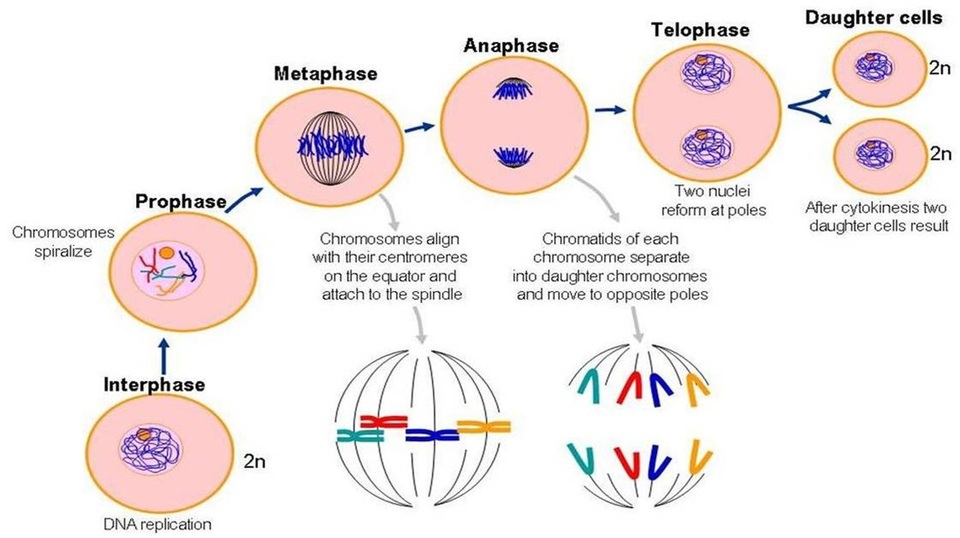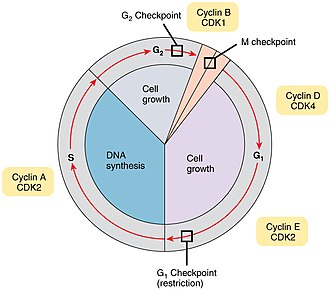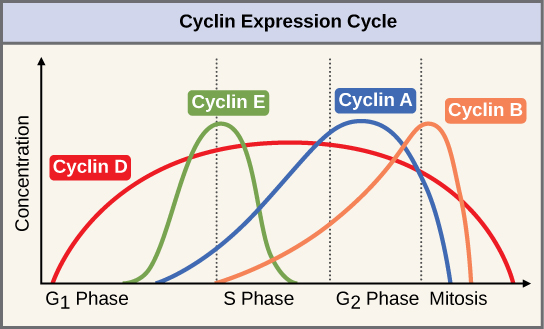Regulation of Cell Cycle Study Guide
Introduction
The cells on the path of division pass through a series of carefully regulated and well-timed growth stages, replication of DNA, and cytoplasmic and nuclear division, which ultimately makes two identical or clone cells. The cell type and its development stage determine the frequency of cell division. The cell cycle is a complex process that is highly regulated, so let’s learn more about it.
Interphase and Mitosis
Control of the Cell Cycle
The cycle of the cell length is variable in the cells of every organism. The event timing in the cell cycle is controlled by the mechanisms that are either external or internal to the cell.
Cell cycle checkpointsThe checkpoint is a stage in the eukaryotic cell cycle when the cell looks at the eternal and internal cues and then decides whether or not to go ahead with division. There are several checkpoints, but the three important ones are:
- The G1 checkpoint, which occurs at the G1/S transition
- The G2 checkpoint that happens at the G2/M transition
- The spindle checkpoint which occurs during the metaphase to anaphase transition
Regulations of the Cell Cycle at the Internal Checkpoints
The daughter cell should be an exact duplicate of the parent cell. If there are any mistakes in the distribution or duplication of the chromosome, then this leads to mutation. This will get passed to the new cell produced by the abnormal cell. To not let the compromised cell divide, some internal control mechanisms operate at the checkpoint in the cell cycle.
The cell cycle could be stopped until the favorable conditions or the errors are corrected. These checkpoints in the cell cycle are towards the end of the G1 and the G2 and the metaphase checkpoint.
Cell Cycle Checkpoints
The cell cycle is controlled at three checkpoints. The DNA integrity is assessed at the G1-S checkpoint, and the chromosome duplication is properly is checked at the G-M checkpoint. The attachment of every kinetochore to the spindle fiber is assessed at the M-checkpoint.
-
The G1-s checkpoint is the cell’s main decision point. This is the main point where a cell decides whether or not to divide. When the cell divides, the end subscript enters the S phase.
-
To ensure that cell division runs smoothly and produces a healthy daughter cell with undamaged and complete DNA, the cell undergoes another checkpoint before the M phase. Thus the G2 checkpoint helps to maintain genomic stability.
-
The M checkpoint or the spindle checkpoint is where the cell examines whether all its sister chromatids are attached correctly to the spindle microtubules. The cycle cell will not move forward unless all the chromosomes get attached firmly to at least two of the spindle fibers.
Cell Cycle Regulator Molecules
- Apart from the cell cycle checkpoints that are internally controlled, two groups of intracellular molecules regulate the cell cycle.
- Cell cycle regulators promote the cell progress to the next phase, which is positively regulated. They may also halt the cycle called negative regulation of the cell cycle.
- The regulator molecules could act individually or induce the regulatory proteins’ activity or production.
- The failure of the single regulator could have absolutely no effect on the cell cycle if more than a single mechanism controls the event.
- The impact of the non-functioning or the deficient regulator can be fatal or wide-ranging to the cell if multiple processes get affected.
Positive Cell Cycle Regulation
- The two protein groups, the cyclins and the cyclin-dependent kinases, are the positive regulators.
- These are responsible for cell cycle progression through several checkpoints. The cyclin protein level predictably fluctuates through the cell cycle.
- Both the external and the internal signals will trigger an increase in the expression of the cyclin that is specific to each ell stage.
- After the cell proceeds to the next stage of the cell cycle, the cyclins active in the previous stage get degraded by proteasomes.
Negative Cell Cycle Regulation
- The second cycle of the cell regulatory molecules is negative, stopping the cell cycle. Retinoblastoma proteins are negative regulators of the G1 to S cell cycle transition.
- The retinoblastoma is a tumor suppressor protein and functions to prevent any excessive cell growth. This they do by inhibiting cell cycle progression until a cell is ready to divide.
Disruptions to the Cell Cycle
- Cell cycle control is essential.
- Cancer is unchecked cell growth.
- It can occur in two ways. Either a mutation in a gene that causes an increase in cell division rates or a gene that inhibits normal controls on the system, such as cell cycle arrest or programmed cell death.
- Checkpoints can delay cell cycle progression or induce cell cycle exit or death in response to irreparable DNA damage.
- Cancer-associated mutations that disturb cell cycle control allow continuous and excessive cell division primarily by affecting the ability of cells to leave the cell cycle.
- Apoptosis is the process of programmed cell death (PCD). It is used during development and aging to eliminate any unwanted cells.
- DNA damage in some cells that are beyond repair can lead to apoptotic death. Apoptosis acts as a homeostatic mechanism to maintain cell populations in tissues, as a defense mechanism in immune reactions or when cells are injured by disease or noxious agents.
- Inappropriate apoptosis (either too little or too much) is a factor in many human conditions including many types of cancer, neurodegenerative diseases, and autoimmune disorders.
Conclusion
- Every cell cycle step gets monitored by the internal controls, which are the cell cycle checkpoints.
- There are three main cell cycle checkpoints. One is near the G1, the second is in the G2 and M-transition, and the third is during the metaphase.
- The positive regulator molecule lets the cell cycle advance to the next stage.
- The negative regulator molecule monitors the cellular conditions and halts the cell cycle until the specific needs are met.
FAQs:
1. What happens when the regulation of the cell cycle goes wrong?
If the cell cycle goes out of control, cell growth would go unchecked and lead to damaged DNA being passed down from one cell to another. Also these mutations and alterations give rise to tumorigenesis which then leads to cancer.
2. Why is there a need for cell cycle regulation?
If a cell cycle is not regulated, the cell may constantly go through excessive cell division. Cell cycle regulation is crucial for cellular homeostasis and prevention of many types of cencers.
3. What would happen if there were no checkpoints in the cell cycle?
Without a checkpoint, there would be no way to prevent cells from dividing with damaged DNA, which could spread mutations and give rise to tumorigenesis. Checkpoints also allow cells additional time to repair the DNA damage, which would not be possible usually.
4. Is it advisable for all cells to enter the G0 phase?
Not necessarily. Terminally differentiated cells such as neurons, myocytes, or surface epithelial cells of skin and mucosa remain in the G0 phase, whereas other cells use the G0 state as a resting state until they receive appropriate signals to re-enter and progress through the cell cycle.
We hope you enjoyed studying this lesson and learned something cool about the Regulation of the Cell Cycle! Join our Discord community to get any questions you may have answered and to engage with other students just like you! Don’t forget to download our App to experience our fun, VR classrooms – we promise, it makes studying much more fun! 😎
Sources:
- Cell cycle regulators. https://www.khanacademy.org/science/ap-biology/cell-communication-and-cell-cycle/regulation-of-cell-cycle/a/cell-cycle-regulators. Accessed 20 Dec, 2021.
- Control of the Cell Cycle. https://courses.lumenlearning.com/biology1/chapter/control-of-the-cell-cycle/. Accessed 20 Dec, 2021.
- Cell-cycle regulation. http://www.wormbook.org/chapters/www_cellcyclereguln/cellcyclereguln.html. Accessed 20 Dec, 2021.
- Chapter 13: The Cell Cycle and Its Regulation. https://alg.manifoldapp.org/read/fundamentals-of-cell-biology/section/78a4b49f-eb14-40a1-9ea7-196821b7d5de. Accessed 20 Dec, 2021.



